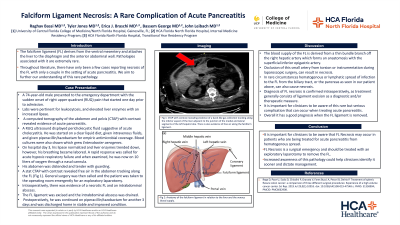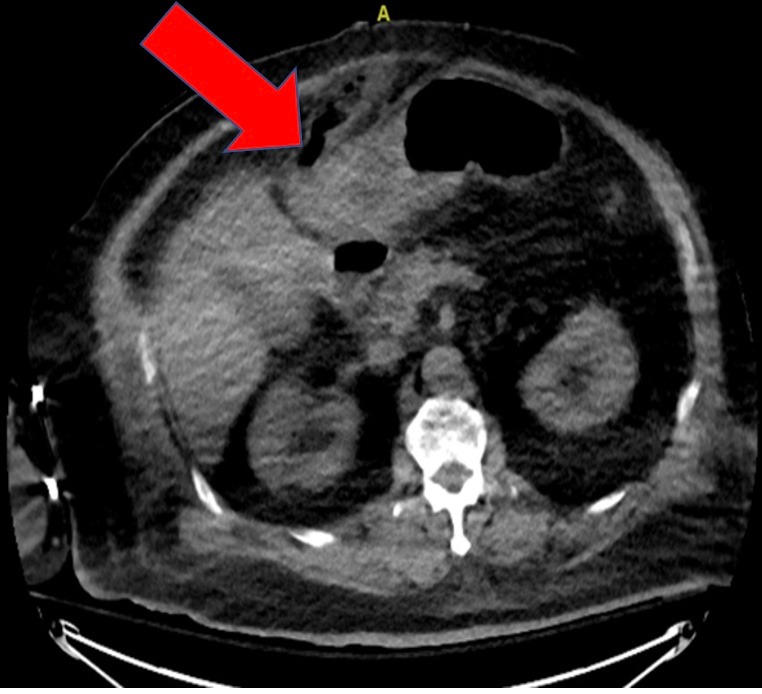Tuesday Poster Session
Category: Biliary/Pancreas
P2995 - Falciform Ligament Necrosis: A Rare Complication of Acute Pancreatitis
Tuesday, October 24, 2023
10:30 AM - 4:00 PM PT
Location: Exhibit Hall

Has Audio

Raghav Bassi, MD
University of Central Florida
Gainesville, FL
Presenting Author(s)
Raghav Bassi, MD, Tyler Jones, MD, Erica J. Braschi, MD, John Leibach, MD
University of Central Florida, Gainesville, FL
Introduction: The falciform ligament (FL) derives from the ventral mesentery and attaches the liver to the diaphragm and the anterior abdominal wall. Pathologies associated with it are extremely rare. Throughout literature there have only been a few cases describing necrosis of the FL and even less in the setting of acute pancreatitis. We aim to further our understanding of this rare pathology.
Case Description/Methods: A 74- year old male presented with sudden onset of right upper quadrant (RUQ) pain that started one day ago. He described it as a sharp, persistent pain with associated nausea and vomiting. On presentation he was tachycardic and tachypneic but remained hemodynamically stable. Labs were pertinent for leukocytosis, and elevated liver enzymes with an increased lipase. A computed tomography of the abdomen and pelvis (CTAP) with contrast revealed evidence of acute pancreatitis. A RUQ ultrasound displayed pericholecystic fluid suggestive of acute cholecystitis. He was started on a clear liquid diet, given intravenous fluids, and given piperacillin/tazobactam for empiric antimicrobial coverage. Blood cultures were also drawn which grew Enterobacter aerogenes. On hospital day 3, his lipase normalized and liver enzymes trended down, however, his breathing became labored. A rapid response was called for acute hypoxic respiratory failure and when examined, he was on 10 liters of oxygen through a nasal canula. His abdomen was distended and tender with guarding. A stat CTAP with contrast revealed free air in the abdomen tracking along the FL (Fig 1). General surgery was then called and the patient was taken to the operating room emergently for an exploratory laparotomy. Intraoperatively, there was evidence of a necrotic FL and an intrabdominal abscess. The abscess was drained with excision of the FL without any complications. He was ultimately discharged home in stable condition.
Discussion: The blood supply of the FL is derived from a thin bundle branch off the right hepatic artery which forms an anastomosis with the superficial inferior epigastric artery. Occlusion of this small artery from torsion or instrumentation during laparoscopic surgery, can result in necrosis. Furthermore, hematogenous or lymphatic spread of infection to the FL from the biliary tract or the pancreas, as seen in our patient above, can also cause necrosis. Therefore, it is important for clinicians to be aware of this rare but serious complication that can occur when treating acute pancreatitis.

Disclosures:
Raghav Bassi, MD, Tyler Jones, MD, Erica J. Braschi, MD, John Leibach, MD. P2995 - Falciform Ligament Necrosis: A Rare Complication of Acute Pancreatitis, ACG 2023 Annual Scientific Meeting Abstracts. Vancouver, BC, Canada: American College of Gastroenterology.
University of Central Florida, Gainesville, FL
Introduction: The falciform ligament (FL) derives from the ventral mesentery and attaches the liver to the diaphragm and the anterior abdominal wall. Pathologies associated with it are extremely rare. Throughout literature there have only been a few cases describing necrosis of the FL and even less in the setting of acute pancreatitis. We aim to further our understanding of this rare pathology.
Case Description/Methods: A 74- year old male presented with sudden onset of right upper quadrant (RUQ) pain that started one day ago. He described it as a sharp, persistent pain with associated nausea and vomiting. On presentation he was tachycardic and tachypneic but remained hemodynamically stable. Labs were pertinent for leukocytosis, and elevated liver enzymes with an increased lipase. A computed tomography of the abdomen and pelvis (CTAP) with contrast revealed evidence of acute pancreatitis. A RUQ ultrasound displayed pericholecystic fluid suggestive of acute cholecystitis. He was started on a clear liquid diet, given intravenous fluids, and given piperacillin/tazobactam for empiric antimicrobial coverage. Blood cultures were also drawn which grew Enterobacter aerogenes. On hospital day 3, his lipase normalized and liver enzymes trended down, however, his breathing became labored. A rapid response was called for acute hypoxic respiratory failure and when examined, he was on 10 liters of oxygen through a nasal canula. His abdomen was distended and tender with guarding. A stat CTAP with contrast revealed free air in the abdomen tracking along the FL (Fig 1). General surgery was then called and the patient was taken to the operating room emergently for an exploratory laparotomy. Intraoperatively, there was evidence of a necrotic FL and an intrabdominal abscess. The abscess was drained with excision of the FL without any complications. He was ultimately discharged home in stable condition.
Discussion: The blood supply of the FL is derived from a thin bundle branch off the right hepatic artery which forms an anastomosis with the superficial inferior epigastric artery. Occlusion of this small artery from torsion or instrumentation during laparoscopic surgery, can result in necrosis. Furthermore, hematogenous or lymphatic spread of infection to the FL from the biliary tract or the pancreas, as seen in our patient above, can also cause necrosis. Therefore, it is important for clinicians to be aware of this rare but serious complication that can occur when treating acute pancreatitis.

Figure: Fig 1: CTAP with contrast revealing evidence of a band-like gas collection tracking along the inferior aspect of the liver adjacent to the junction of the medial and lateral segments of the left hepatic lobe. There is also evidence of free air along the falciform ligament.
Disclosures:
Raghav Bassi indicated no relevant financial relationships.
Tyler Jones indicated no relevant financial relationships.
Erica Braschi indicated no relevant financial relationships.
John Leibach indicated no relevant financial relationships.
Raghav Bassi, MD, Tyler Jones, MD, Erica J. Braschi, MD, John Leibach, MD. P2995 - Falciform Ligament Necrosis: A Rare Complication of Acute Pancreatitis, ACG 2023 Annual Scientific Meeting Abstracts. Vancouver, BC, Canada: American College of Gastroenterology.
